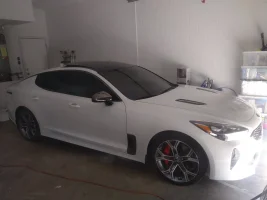Well this is a rather complicated one. Lots of factors to keep in consideration.
Most manufacturers provide different grade
clay bars for different applications. The finer clay bars are usually less coarse and easier to knead, but they also work very slowly, rather abrade away contamination slower than the more abrasive bars. Normally there will be words such as fine, medium and heavy for different types of clay bars, but from my experience they don’t really translate across different manufacturer lines, so my advice is to always do a bit of research on the clay bar, or better yet try it yourself to determine which is which.
Clay bar selection will depend mainly on the level and type of contamination, but also on the paint being decontaminated. When dealing with something like fresh tar or rail dust, a fine clay bar should be all that’s needed and when used properly will either eliminate or greatly reduce the need for polishing after using that clay bar. On the other hand, when the contamination is something that has built up over the years, tree sap or really stubborn tar, a more abrasive clay bar will greatly reduce the working time and many times will even be necessary.
There are many misconceptions about clay bar selection, such as finer clay bars will never leave marring and more aggressive clay bars will work faster. While that may be true for the most part, as mentioned above, there is more to it than that when selecting the right clay bar for your project. Just because a fine clay bar might leave a perfect surface after decontamination doesn’t mean you should spend 4-5 hours removing over-spray or heavy buildup on the paint. Instead, you can use a more aggressive clay bar that will remove the contamination in 1-2 hours, then you can spend the other 3-4 hours polishing the paint and getting a much better result. Similarly, you don’t want to use the aggressive clay bar just because it works faster. Yes maybe you’ll shave off an hour when using a
red Clay Magic bar vs a
blue Clay Magic bar, but you also may end up having to polish that same car for a few hours in order to fix the surface marring left by the red bar. In short, I would recommend following the general rule in detailing when selecting products … start with the finer solution and work your way up as necessary.
But thanks to the advancements in technology we now have alternative solutions that work as effective and as safe as a clay bar. There are a some other alternatives, but these are the two I have used with great results so far. My recommendation will be these:
Nanoskin Autoscrub Speedy Prep Sponge
Griots Garage Brilliant Finish Synthetic Clay




